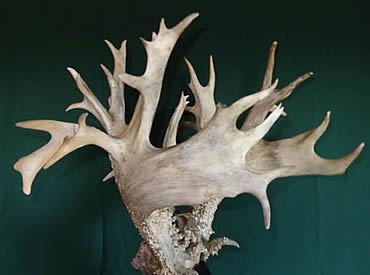’Twas a tiny female fly — not a bullet, broadhead or Buick — that brought down the largest antlered (wild) whitetail in North America last year. And it might have gone undiscovered had a Kansas man not taken a stroll along a creek bank in search of the buck that had dropped off his nephew’s radar.
The deer, while alive, was a well guarded secret within the family. Even now, few people have had the pleasure of ogling its rack.
Photographed regularly by trail camera until late summer 2012, the buck with unfathomable antlers (in velvet at the time) simply disappeared. Clearly, it was either dead or had switched zip codes. Considering that numerous deer throughout the Midwest succumbed to epizootic hemorrhagic disease last year, and since bucks in velvet rarely seek greener pastures unless pressured, it wasn’t difficult to connect the dots.
The deer, in fact, was dead, next to the creek with no holes in it — an almost sure sign that it died from contracting EHD. Even more convincing is that the skull and 55-point rack weigh almost nothing; having never reached the dense hard-antler state.
An official BTR score of 315 makes it the largest free-ranging buck ever recorded from Kansas, fifth-largest in the world, and it’s No. 3 among the world’s biggest pickups, second only to the Barnacle and Hole in the Horn bucks. Its composite score (with the inside spread) is 330 7/8 inches.
The rack’s most outstanding feature, other than its 55 scoreable points, is its mass: 67 4/8 inches in circumference measurements. That’s nearly 30 more than the Hole in the Horn Buck carries.
Before anyone cries foul, the deer is legit. It wasn’t poached. It isn’t an escaped breeder buck. The property owner has numerous trail camera photographs of the animal. The man who found it, uncle to the young hunter who set out and monitored the cameras, has a salvage tag issued by the Kansas Department of Wildlife and Parks.
So why isn’t his name given?
The man’s not interested in notoriety. Neither does he want to draw attention to the family’s ground. But he does recognize that the buck he found on Sept. 20 and the state that produced it should get their due.
 This fabulous buck wasn’t the only high-scoring whitetail that fell victim to the flies in 2012, and Kansas wasn’t the only state hit hard by the EHD virus, which typically surfaces as early as late July and as late as September. It’s almost never seen after the year’s first frost outside the Deep South.
This fabulous buck wasn’t the only high-scoring whitetail that fell victim to the flies in 2012, and Kansas wasn’t the only state hit hard by the EHD virus, which typically surfaces as early as late July and as late as September. It’s almost never seen after the year’s first frost outside the Deep South.
EHD is transmitted by little biting flies called midges. The size of gnats, they look more like corpulent low-riding mosquitoes under a microscope. And as with mosquitoes, it’s the females who bite, the blood necessary for the production of eggs.
Humans and pets can’t contract the virus, but ungulates (whitetails, mule deer, elk, antelope, cattle, goats and sheep) are susceptible, though it’s usually fatal only in deer. Infected deer can show symptoms — high fever, internal bleeding, sluggishness, difficulty breathing, loss of appetite, and swelling of the head, neck, eyelids and tongue — within five to 10 days of being bitten. Once these start, death can follow in as few as 24 hours.
Biologists with the Michigan DNR say deer initially lose their appetite and fear of man and grow progressively weaker. They often salivate excessively, develop rapid pulse and respiration rates, and experience fever, the latter causing them to seek the coolness of water and shade. They’ll eventually lose consciousness.
Internal hemorrhaging and a lack of oxygen in the blood often cause the oral mucosa to appear bluish, which is how one of these viruses came to be called “blue tongue.” Although often used interchangeably to describe the same symptoms, EHD and blue tongue are different viruses.
Since midges are born and die within a six-week period — although the last larval stage can over-winter — both viruses surface and kill deer every year. The number of fatalities ranges widely from negligible to near annihilation. And outbreaks can sometimes seem to skip farms.
One landowner might never encounter a dead deer, even if he has water sources. His neighbor could find 30 or 40 carcasses in a single woodlot.
Well known deer hunter and writer Mike Hanback wrote of Montana in 2011: “More than 90 percent of the whitetails along the five-mile stretch of river where we hunt have been killed (by EHD).”
Nationwide, the disease took a far greater toll in 2012. Major outbreaks have been confirmed in at least 21 states. It’s difficult to say exactly how many deer were killed because states do not require hunters or landowners to report carcasses. Even if they did, there might be no way to confirm causes of death, since the virus deteriorates rapidly when the host dies.
Nevertheless, concerned outdoorsmen and farmers made some calls. Plus, harvest figures have been compiled. And the reports buoy suspicions.
Editor’s Note: Want to read more tales about the world’s greatest whitetails? Subscribe to Rack magazine by calling 1-800-240-3337.
View Official BTR SCORESHEET for James Wanklyn.
Taken By: James Wanklyn
BTR Official Score: 315
BTR Composite Score: 330 7/8
Harvested With: Pick-Ups Shed Antler
Category: Irregular
Location: Marshall County, KS
Date: September 20, 2012